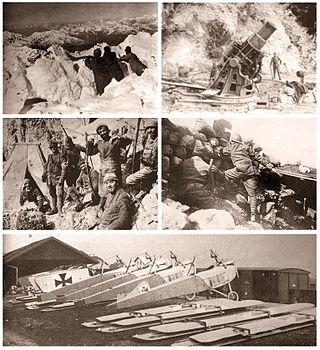Related Research Articles

Operation Compass was the first large British military operation of the Western Desert Campaign (1940–1943) during the Second World War. British, Empire and Commonwealth forces attacked Italian forces of the 10th Army in western Egypt and Cyrenaica, the eastern province of Libya, from December 1940 to February 1941.
Operation Husky order of battle is a listing of the significant military and air force units that were involved in the campaign for Sicily, July 10 – August 17, 1943.

The Italian front,Alpine front. In Croatian historiography, this theathre is commonly referred to as Isonzo front by Isonzo/Soča river. It involved a series of battles at the border between Austria-Hungary and Italy, fought between 1915 and 1918 in the course of World War I. Following secret promises made by the Allies in the 1915 Treaty of London, Italy entered the war aiming to annex the Austrian Littoral, northern Dalmatia, and the territories of present-day Trentino and South Tyrol. Although Italy had hoped to gain the territories with a surprise offensive, the front soon bogged down into trench warfare, similar to that on the Western Front in France, but at high altitudes and with very cold winters. Fighting along the front displaced much of the local population, and several thousand civilians died from malnutrition and illness in Italian and Austro-Hungarian refugee camps. The Allied victory at Vittorio Veneto, the disintegration of the Habsburg empire, and the Italian capture of Trento and Trieste ended the military operations in November 1918. The armistice of Villa Giusti entered into force on 4 November 1918, while Austria-Hungary no longer existed as a unified entity. Italy also refers to the Great War as the Fourth Italian War of Independence, which completed the last stage of Italian unification.

The Structure of the Argentine Army follows below. As of 2020 the active force of the Argentine Army includes a total of eleven brigades:
This article covers the Japanese garrisons on the by-passed Pacific islands from 1944 to 1945, including the Japanese mandated territory of the South Seas Mandate.
Operation Battleaxe was a British Army offensive during the Second World War to raise the Siege of Tobruk and re-capture eastern Cyrenaica from German and Italian forces. The offensive's failure led to the replacement of British General Sir Archibald Wavell, Commander-in-Chief Middle East, by Claude Auchinleck; Wavell took Auchinleck's position as Commander-in-Chief, India.
The Order of battle of the East African campaign shows the ground forces of both sides in East Africa on the date that the Italians declared war on Britain and France, 10 June 1940 and for the British and Commonwealth forces involved in the 1941 offensive.
The Balkan Front was a military formation of the Bulgarian People's Army, intended for wartime use under the general direction of the Soviet General Staff. If a war was to have broken out between NATO and the Warsaw Pact, the bulk of the Bulgarian army would have been assigned to it.

The 2nd Alpine Division "Tridentina" was a division of the Royal Italian Army during World War II, which specialized in mountain warfare. The Alpini that formed the divisions are a highly decorated and elite mountain corps of the Italian Army comprising both infantry and artillery units. The name Tridentina was chosen as the division was based in the Trentino-South Tyrol region, for which the fascist regime of Benito Mussolini had created the neologism Venezia Tridentina. After World War II, the traditions and name of the 2nd Alpine Division "Tridentina" were carried on by the Alpine Brigade "Tridentina".
The Agrupación XXIII de Marzo was upgraded to Division status as the Division XXIII Marzo prior to the Battle of Santander. It was one of the Italian Blackshirts units sent to Spain during the Spanish Civil War to make up the "Corpo Truppe Volontarie", or CTV. Was strengthened after the end of the War in the North for the Aragon Offensive in 1938 with 2nd CCNN Division "Fiamme Nere" and renamed XXIII Marzo Division "Fiamme Nere".
This is the order of battle for the ground forces involved in Operation Crusader, a World War II battle between the British Commonwealth and the European Axis Powers of Germany and Italy in North Africa between 18 November – 30 December 1941.

The 50th Infantry Division "Regina" was an infantry division of the Royal Italian Army during World War II. The Regina was formed on 1 March 1939 in the Italian Islands of the Aegean and entitled to the Queen. After the announcement of the Armistice of Cassibile between Italy and the Allies on 8 September 1943 the division fought Wehrmacht forces in the Battle of Rhodes. The majority of the division surrendered on 11 September 1943, while the III Battalion, 10th Infantry Regiment "Regina" resisted the Germans on Leros until 16 November 1943.
This is an order of battle of the Chilean Army.

The Voluntary Militia for National Security, commonly called the Blackshirts or squadristi, was originally the paramilitary wing of the National Fascist Party, known as the Squadrismo, and after 1923 an all-volunteer militia of the Kingdom of Italy under Fascist rule, similar to the SA. Its members were distinguished by their black uniforms and their loyalty to Benito Mussolini, the Duce (leader) of Fascism, to whom they swore an oath. The founders of the paramilitary groups were nationalist intellectuals, former army officers and young landowners opposing peasants' and country labourers' unions. Their methods became harsher as Mussolini's power grew, and they used violence and intimidation against Mussolini's opponents. In 1943, following the fall of the Fascist regime, the MVSN was integrated into the Royal Italian Army and disbanded.
The 2nd Home Counties Division was a 2nd Line Territorial Force division of the British Army in World War I. The division was formed as a duplicate of the 44th Division in November 1914. As the name suggests, the division recruited in the Home Counties, particularly Kent, Middlesex, Surrey and Sussex. In August 1915, in common with all Territorial Force divisions, it was numbered as 67th Division. Between September 1917 and the end of the year, the division was extensively reorganized and lost its territorial identity; henceforth it was known as 67th Division.
The Order of battle, Keren 1941 shows Italian army forces that participated in the Battle of Keren from February to March 1941 and British troops in Sudan on 20 January 1941, which participated in military operations against Eritrea during the East African Campaign 1940–1941.
The Structure of the Egyptian Expeditionary Force over the course of the First World War is shown below.
References
- ↑ Beevor, Antony. The Spanish Civil War. p. 158. ISBN 0-911745-11-4